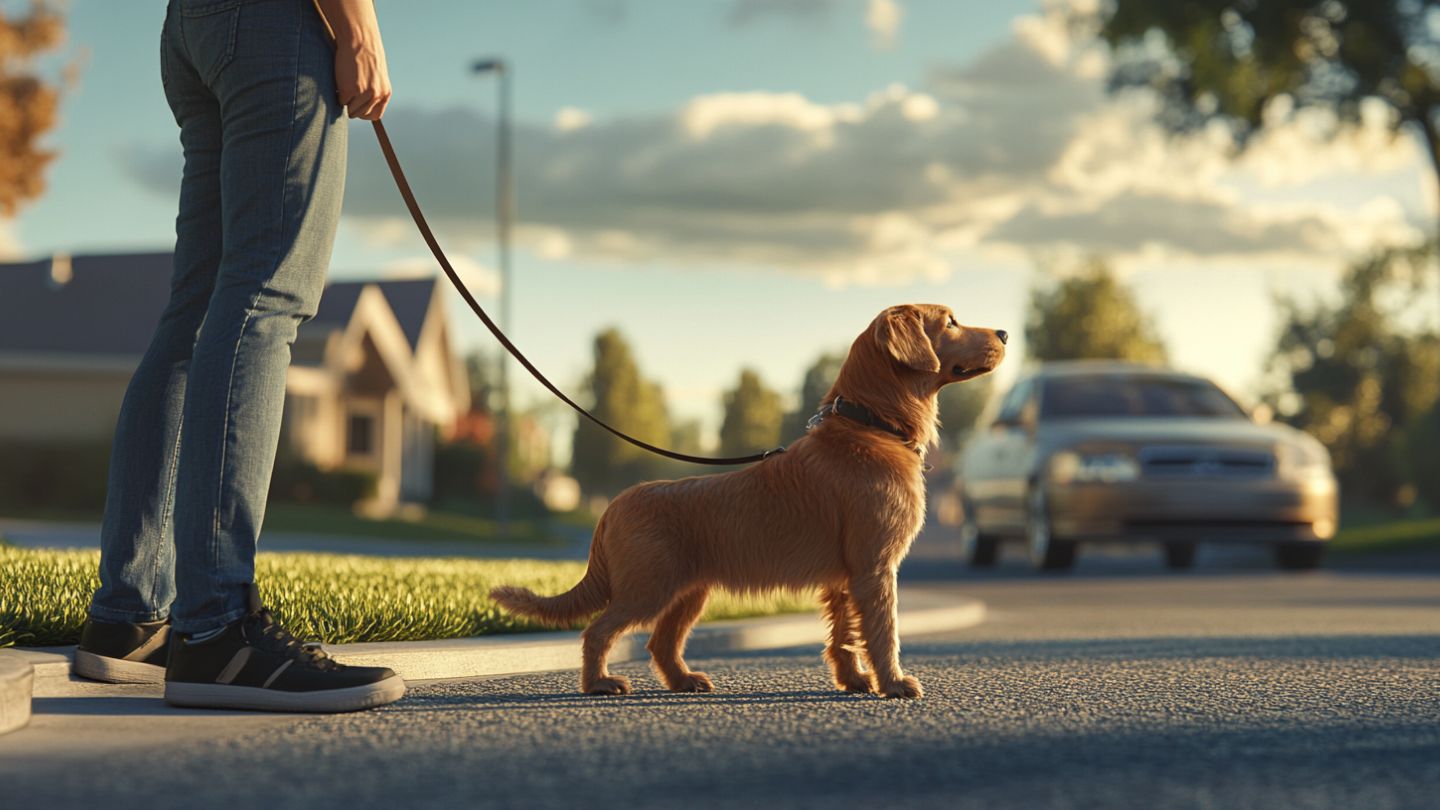Does your furry friend turn into a four-legged speed demon at the sight of a moving vehicle?
Car chasing is not just annoying; it’s downright dangerous for your dog, drivers, and pedestrians.
But don’t worry, we’ve got your back (and your dog’s tail)!
Here are seven management tactics to help curb your dog’s car-chasing habits and keep everyone safe.
1. Leash Up for Safety
The Power of Control
A sturdy leash is your first line of defense against car chasing.
Always keep your dog on a leash during walks, especially in areas with traffic.
Choose the Right Equipment
Consider a front-clip harness or head halter for better control.
These tools can help redirect your dog’s attention more easily than a regular collar.
Practice Makes Perfect
Use quiet streets to practice walking calmly on a leash near slow-moving traffic.
Reward your dog for focusing on you instead of the cars.
2. Create a Distraction Arsenal
The Power of Treats
Carry high-value treats that your dog absolutely loves.
Use these to redirect their attention when a car approaches.
Toy Time
For dogs motivated by play, a favorite toy can be a great distraction.
A quick game of tug can shift focus from the tempting moving vehicle.
The Sound Strategy
A small noise maker or clicker can be used to capture your dog’s attention quickly.
Pair the sound with treats to create a positive association.
3. Establish a Solid “Leave It” Command
Start Small
Begin teaching “leave it” with stationary objects in a controlled environment.
Gradually increase difficulty as your dog masters the basics.
Apply to Moving Objects
Once your dog understands “leave it” for stationary items, practice with moving objects like rolling balls.
This bridges the gap to ignoring moving vehicles.
Real-World Application
Use “leave it” during walks when cars approach.
Reward generously for compliance to reinforce the behavior.
4. Desensitization: Make Cars Boring
Start from a Distance
Begin by watching traffic from afar, where your dog notices cars but isn’t tempted to chase.
Reward calm behavior.
Gradually Decrease Distance
Slowly move closer to roads over multiple sessions.
Always prioritize your dog’s comfort level and safety.
Stationary Practice
If possible, have a friend slowly drive past while you work with your dog in a safe, enclosed area.
Reward for remaining calm and focused on you.
5. Provide Mental and Physical Stimulation
Tire Them Out
A tired dog is less likely to engage in problematic behaviors.
Ensure your pup gets plenty of exercise before walks near traffic.
Mental Workouts
Incorporate puzzle toys and training sessions into your dog’s routine.
Mental stimulation can be as tiring as physical exercise.
Alternative Outlets
Teach your dog appropriate chasing games, like fetch, to satisfy their chase instinct in a controlled manner.
6. Create Barriers When Necessary
Secure Your Yard
If your dog chases cars from your property, consider installing a solid fence or reinforcing existing fencing.
Use of Long Lines
In open areas, a long training lead can give your dog freedom while maintaining control.
Visual Barriers
Sometimes, blocking the view of the road can reduce temptation.
Consider privacy fencing or strategic landscaping.
7. Seek Professional Help
Consult a Trainer
If car chasing persists, don’t hesitate to seek help from a professional dog trainer or behaviorist.
They can provide personalized strategies and hands-on guidance.
Group Classes
Controlled group training classes can provide valuable socialization and distraction training opportunities.
Veterinary Input
Sometimes, car chasing can be a sign of anxiety or other health issues.
Consult your vet to rule out any underlying medical conditions.
Conclusion: Safety First, Always!
Managing a dog with a penchant for car chasing requires patience, consistency, and a good dose of creativity.
Remember, this behavior didn’t develop overnight, and it won’t disappear instantly either.
Stay committed to these management tactics, and you’ll see improvement over time.
The most important thing is keeping your furry friend safe.
Even as your dog’s behavior improves, always err on the side of caution near traffic.
A moment of distraction can have serious consequences.
By implementing these strategies, you’re not just curbing a dangerous habit; you’re also strengthening your bond with your dog through training and positive experiences.
It’s a win-win situation that leads to a happier, safer life for both you and your four-legged companion.
Share this post with fellow dog owners who might be struggling with car-chasing pups.
Together, we can make our streets safer for dogs, drivers, and pedestrians alike!
Remember, every dog can learn new tricks – even if that trick is ignoring speeding vehicles.
With patience, love, and these management tactics, your car-chasing canine can become a model of roadside etiquette.
Here’s to safe walks and happy tails!
SHARE now with your friends!
- Hero Farm Dog Survives Epic Battle with Coyote Pack - December 9, 2024
- The 10-Minute Bedtime Routine That Changed My Dog’s Sleep Forever - November 29, 2024
- Creating a Safe Space for Nervous Pets: Your Guide to Pet-Friendly Havens - November 25, 2024

